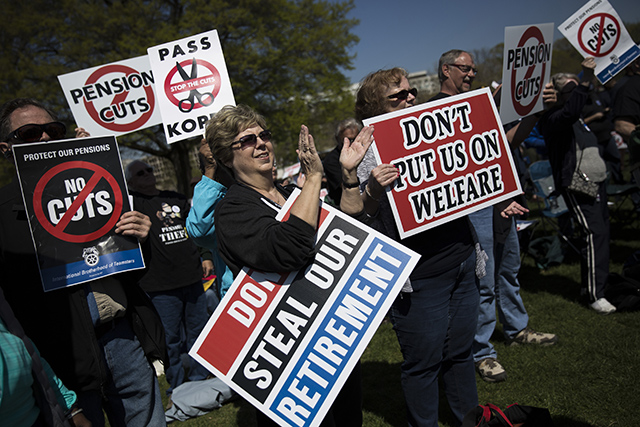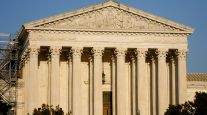In New York, Teamsters Protest Possible Pension Cuts

A group of retired Teamsters demonstrated in front of the Leo W. O'Brien federal building in Albany, New York, on June 6 to protest pending threats to their pensions and to highlight the need for Congress to take action.
The march, largely by retired truck drivers, comes as dozens of union pensions nationwide are in danger of serious shortfalls or insolvency due to declining membership over time.
And, retirees noted, it comes after Congress has, over the years, passed laws that have allowed further depletion of pension plan coffers.
Now, the looming shortfalls could force millions of retirees nationwide to swallow steep cuts to their pensions unless something is done.
RELATED: Democrats Press McConnell to Fix Pensions
"You're going to have a lot of people going on welfare," said Pat Albert, who attended the rally with her husband, Bud, a retired Teamsters trucker.
Bud Albert, 83, spent years as a truck driver for a variety of firms in the Capital region and Vermont and gets a pension from the NYS Teamsters Conference pension system.
It's a so-called multiemployer pension plan. Under these plans, Teamsters would keep their pension credits as they moved from job to job.
That approach worked well in past decades. But after deregulation in the 1980s, consolidation in the industry and a declining percentage of unionized workers, many of these plans are running out of money.
One of the largest, the Central States Pension Fund, more than a year ago said it was going to have to cut benefits in order to remain solvent. That hasn't happened. Earlier this month, the U.S. Treasury Department rebuffed a plan for cuts that was scheduled for July. But union retirees in that plan, including several dozen in the Capital region — as well as the NYS Teamsters Conference members — are nonetheless bracing for future cuts.
RELATED: Central States Won’t Create New Pension Rescue Plan, Appeals to Congress for Help
NYS Teamsters Conference members have been writing their congressional and Senate representatives but have gotten a tepid response at best.
Democratic 20th District Rep. Paul Tonko has met with the group, and Democratic Sen. Chuck Schumer has responded with letters, saying that the Senate Republican majority is blocking changes.
They haven't heard back from others, including Democratic Sen. Kirsten Gillibrand or North Country Republican Rep. Elise Stefanik from the 21st Congressional District. Republican Chris Gibson, in the 19th District, has responded but didn't make any promises.
In order for the plans to cut benefits, they needed permission from Congress, which happened two years ago.
Managers of the endangered plans say they need to make cuts or they'll go broke. And with dozens of plans in danger, Congress has said that would put too much pressure on the federal Pension Benefit Guarantee Corp. which provides a backstop for pensions that are in trouble.
Teamsters and others, however, maintain there are other options, such as tapping some of the multibillion-dollar settlements coming in from major investment banks resulting from misdeeds that helped foment the 2008 financial collapse.
"The taxpayers bailed out Wall Street. Then those guys got millions of dollars of bonuses," remarked Ted Oleski, president of the NYC Conference retirees group.
Tom Baum, the retirees' representative for the NYS Conference, said he hopes that political pressure leads to action. "Obama doesn't want this to happen on his watch," he said.
Like many of the marchers, Baum is a retired UPS driver.
He realizes there are fewer union members than before. But he noted Congress since the 1980s, through a series of complex and obscure laws, has helped chip away at the health of private sector pensions (Public sector pensions in New York and others states are constitutionally guaranteed, so if they run short of money, the government simply raises taxes or gets money through other savings to make up the shortfall).
Congress for example, greatly increased taxes on pension "overfunding." That, however, meant there were far less reserves in many pension funds when the 2008 financial crash came along.
And they placed limits on the liability that employers have for pension agreements when a company is sold.
Pensions received by the retirees vary, depending on when they worked and for how long. At the top end, those who spent decades working at UPS Inc., which offers top pay, can enjoy pensions of $60,000 or more.
UPS ranks No. 1 on the Transport Topics Top 100 list of the largest U.S. and Canadian for-hire carriers.
But those who worked at smaller firms, or who retired decades ago when wages and benefits were far lower, get a fraction of that amount.
Nationally, hundreds of thousands of retirees who are in multiemployer plans are in danger of seeing their pensions cut over the next couple of years, if action isn't taken, Baum said.
In upstate New York alone, there are 16,000 in the NYS Conference plan, including about 2,000 in the Capital region.




